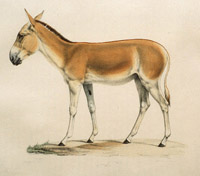
Erforschung biologischer Ressourcen der Mongolei / Exploration into the Biological Resources of Mongolia, ISSN 0440-1298
Date of this Version
2007
Document Type
Article
Citation
Erforschung biologischer Ressourcen der Mongolei (2007) band 10: 243-251.
This manuscript is based on the following original paper: BAHLOUL, K.; PERELADOVA, O.B.; SOLDATOVA, N.; SIDORENKO; E.; SEMPERE, A.J. (2001): Social organization and dispersion of introduced kulans (Equus hemionus kulan) and Przewalski horses (Equus przewalski) in the Bukhara Reserve, Uzbekistan. – J. Arid Environ. 47: 309-323.
Abstract
Asiatic wild asses and Przewalski's horses initially inhabited steppe, semi-desert and desert areas, but Przewalski's horses became extinct in the wild, and kulans are under threat of disappearance. The Bukhara Breeding Centre (Uzbekistan) was created in 1976 for conservation and reintroduction of wild ungulate species. In 1977-1978, five kulans (two males and three females) from Barsa-Kelmes Island on the Aral lake were introduced to the reserve. The group increased to 25-30 animals in 1995-1998, when five Przewalski's horses from Moscow and St. Petersburg zoos were introduced to the same territory. We analyzed the home ranges, preferred habitats and social interactions of these closely related species during 1995-1999 by season and group composition. Horses and kulans each formed a reproductive group and a secondary bachelor group. The home range of the secondary group in both species was larger then that of the reproductive group and seemed to be less dependent on watering places. Kulans and Przewalski's horses demonstrated different strategies of habitat use. They can share one area without serious conflicts, avoiding competition by the temporal differentiation in the usage of key sites.
Included in
Asian Studies Commons, Biodiversity Commons, Environmental Sciences Commons, Nature and Society Relations Commons, Other Animal Sciences Commons, Population Biology Commons, Terrestrial and Aquatic Ecology Commons, Zoology Commons


Comments
Copyright 2007, Martin-Luther-Universität Halle Wittenberg, Halle (Saale). Used by permission.